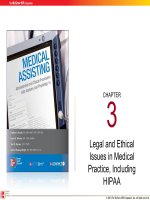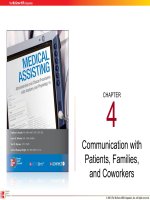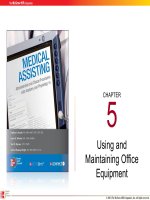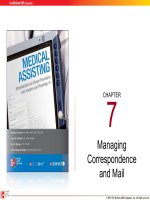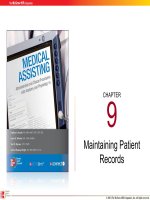Lecture Medical assisting: Administrative and clinical procedures with anatomy and physiology (4e) – Chapter 21
Bạn đang xem bản rút gọn của tài liệu. Xem và tải ngay bản đầy đủ của tài liệu tại đây (1.52 MB, 58 trang )
CHAPTER
21
The Skeletal
System
© 2011 T he McGraw -Hill Com panie s, Inc. A ll rights reserv ed.
21-2
Learning Outcomes
21.1
Describe the parts of a long bone.
21.2
List the substances that make up bone tissue.
21.3
List the functions of bones.
21.4
Identify bones by their classifications.
21.5
Describe how long bones grow.
© 2011 T he McGraw -Hill Com panie s, Inc. A ll rights reserv ed.
21-3
Learning Outcomes (cont.)
21.6
List and describe the skeletal structures and one
location of each structure.
21.7
List the bones of the skull, spinal column, rib
cage, shoulders, arms, hands, hips, legs, and
feet. Describe the location of each bone.
21.8
Define fontanels and explain their importance.
© 2011 T he McGraw -Hill Com panie s, Inc. A ll rights reserv ed.
21-4
Learning Outcomes (cont.)
21.9
Describe the three major types of
joints and give examples of each.
21.10 Describe the structure of a synovial
joint.
21.11 Describe the causes, signs and
symptoms, and treatments of various
diseases and disorders of the skeletal
system.
© 2011 T he McGraw -Hill Com panie s, Inc. A ll rights reserv ed.
21-5
Introduction
•
Bones provide the
body with structure
and support
•
Divisions
–
Axial – 80 bones
•
•
•
206 bones with
joints and
connective tissue
•
–
Skull
Vertebral column
Rib cage
Appendicular – 126
bones
•
•
•
Arms and legs
Pectoral girdle
Pelvic girdle
© 2011 T he McGraw -Hill Com panie s, Inc. A ll rights reserv ed.
21-6
The Skeletal System
© 2011 T he McGraw -Hill Com panie s, Inc. A ll rights reserv ed.
21-7
Bone Structure
•
Bones contain
various kinds of
tissues, including
–
–
–
•
Osseous tissue
Blood vessels
Nerves
Compact Bone
Spongy
Bone
Osseous tissue can
appear compact or
spongy
© 2011 T he McGraw -Hill Com panie s, Inc. A ll rights reserv ed.
21-8
Bone Structure (cont.)
•
Compact bone looks
solid
–
•
Structures can be
observed with a
microscope
All bones are made
up of both compact
and spongy bone
© 2011 T he McGraw -Hill Com panie s, Inc. A ll rights reserv ed.
21-9
Bone Structure (cont.)
© 2011 T he McGraw -Hill Com panie s, Inc. A ll rights reserv ed.
21-10
Bone Structure (cont.)
•
Flat bones – located in the skull and rib cage
– Ribs
– Frontal bone
•
Irregular bones
– Vertebrae
– Bones of the pelvic girdle
© 2011 T he McGraw -Hill Com panie s, Inc. A ll rights reserv ed.
21-11
Gender Differences
• Male Skull
• Male pelvic bones
– Larger and heavier
– Heavier and thicker
– Forehead shorter
– Obturator foramina
and acetabula are
larger and closer
together
– Face less round
– Jaw larger
– Mastoid processes
more prominent
© 2011 T he McGraw -Hill Com panie s, Inc. A ll rights reserv ed.
21-12
Gender Differences (cont.)
• Male pelvic cavity
– Narrower and longer
– Less roomy and more
• Male coccyx
– Less movable
funnel shaped
• Male sacrum
– Narrower
– Sacral promontory
projects forward
– Sacral curvature is
less sharp posteriorly
© 2011 T he McGraw -Hill Com panie s, Inc. A ll rights reserv ed.
21-13
Apply Your Knowledge
Match bone to classification. ANSWER:
L
___
Humerus
L.
F
___
Rib S.
Short bones
L
___
Femur
F.
___
I
Pelvic bones
Irregular bones
I.
___
Carpals
___
Frontal bone
___
Vertebra
Very
Good!
___
Tarsals
S
F
I
S
Long bones
Flat bones
© 2011 T he McGraw -Hill Com panie s, Inc. A ll rights reserv ed.
21-14
Functions of Bones
•
Give shape to body parts
•
Support and protect soft structures
–
•
Examples – brain, lungs, heart
Allow body movement, because skeletal muscles
attach to them
–
Allow for voluntary movement
© 2011 T he McGraw -Hill Com panie s, Inc. A ll rights reserv ed.
21-15
Functions of Bones (cont.)
•
Red bone marrow of
bone produces new
blood cells –
hematopoiesis
•
Store calcium
© 2011 T he McGraw -Hill Com panie s, Inc. A ll rights reserv ed.
21-16
Apply Your Knowledge
Why is it important for the bones to store calcium?
ANSWER: Every cell in the body needs calcium, so the
body must have a large supply readily available.
Correct!
© 2011 T he McGraw -Hill Com panie s, Inc. A ll rights reserv ed.
21-17
Bone Growth
•
Ossification – process of bone
growth
•
Intramembranous ossification
– Bones begin as tough,
fibrous membrane
– Bone-forming cells called
osteoblasts turn the
membrane to bone (located
in skull)
© 2011 T he McGraw -Hill Com panie s, Inc. A ll rights reserv ed.
21-18
Bone Growth (cont.)
•
Endochondral ossification
–
–
Bones begin as cartilage
models
Primary ossification center
•
–
Secondary ossification center
•
•
–
Bone formed in the diaphysis
Epiphyses turn to bone
Bones with some cartilage between an epiphysis and the
diaphysis will continue to grow
Medullary cavity and spaces in cancellous bone
form
•
Cells that form holes in bone are called osteoclasts
© 2011 T he McGraw -Hill Com panie s, Inc. A ll rights reserv ed.
21-19
Building Better Bones
•
Teach healthy behaviors
–
Bone-healthy diet with calcium and
vitamin D
–
Bone-health exercises
Weight-bearing
Strength training
–
Bone-healthy lifestyle
Avoid smoking
Avoid alcohol
© 2011 T he McGraw -Hill Com panie s, Inc. A ll rights reserv ed.
21-20
Bone Tests
•
Bone density
•
Bone scans
•
Diagnose causes of
Bone pain
Arthritis
Bone infections
Bone cancers
© 2011 T he McGraw -Hill Com panie s, Inc. A ll rights reserv ed.
21-21
Apply Your Knowledge
What are the two types of bone growth?
ANSWER: Intramembranous ossification, in which
bones begin as tough membrane and are turned to
bone by osteoblasts, and endochondral ossification, in
which primary ossification occurs in the diaphysis of
the bone and secondary ossification occurs in the
epiphysis.
Good Job!
© 2011 T he McGraw -Hill Com panie s, Inc. A ll rights reserv ed.
21-22
Bony Structures
•
Rigid foundation
•
Projections and processes for muscle and ligament
attachment
•
Depressions and hollows for articulations – the
connection of bones at joints
•
Openings for blood vessels and nerves
© 2011 T he McGraw -Hill Com panie s, Inc. A ll rights reserv ed.
21-23
Bony Structures (cont.)
Term
Definition
Condyle
A rounded process that usually articulates
with another bone
Crest
A narrow, ridge-like projection
Epicondyle
A projection situated above a condyle
Foramen
An opening through a bone that is usually
a passageway for blood vessels, nerves,
or ligaments
Fossa
A relatively deep pit or depression
© 2011 T he McGraw -Hill Com panie s, Inc. A ll rights reserv ed.
21-24
Bony Structures (cont.)
Term
Definition
Head
An enlargement on the end of a bone
Process
A prominent projection on a bone
Suture
An interlocking line of union between
bones
Trochanter
A relatively large process
Tubercle
A small, knoblike process
Tuberosity
A knoblike process, usually larger than a
tubercle
© 2011 T he McGraw -Hill Com panie s, Inc. A ll rights reserv ed.
21-25
Apply Your Knowledge
Match the following:
ANSWER:
E Epicondyle A. A relatively deep pit or depression
___
C Fontanels B. An interlocking line of union between bones
___
A Fossa
___
C. “Soft spots” felt on an infant’s skull
F Process
___
D. A knoblike process, usually larger than a
tubercle
B Suture
___
E. A projection situated above a condyle
D Tuberosity F. A prominent projection on a bone
___
© 2011 T he McGraw -Hill Com panie s, Inc. A ll rights reserv ed.

